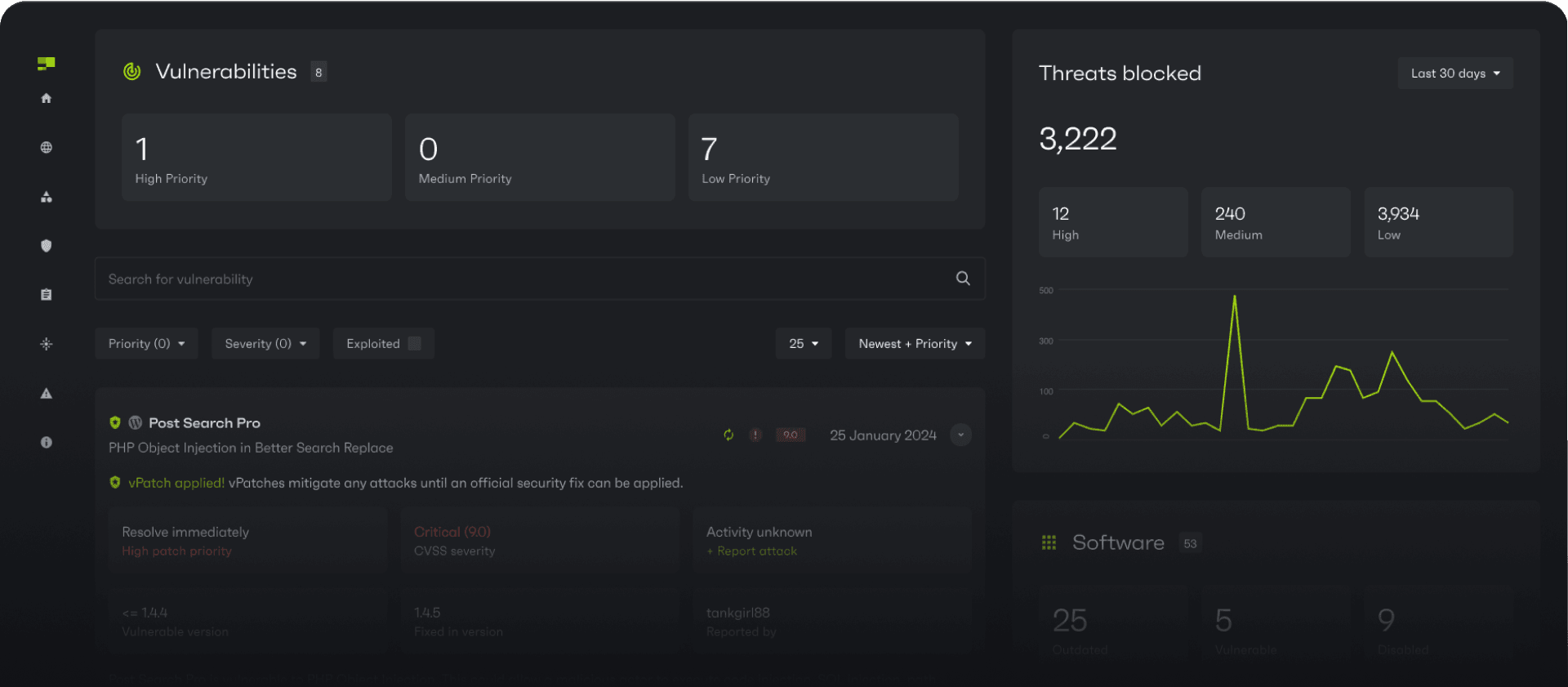Best WPscan alternative
See why 30,000+ websites & leading hosting providers trust Patchstack with their security

Patchstack vs WPScan
Patchstack stops vulnerability attacks in their tracks – combining early detection with rapid protection to keep your WordPress sites safer, sooner.
Benefit
Patchstack
WPscan
Vulnerability intelligence
#1 WordPress vulnerability discloser globally, fastest to protect against new vulnerabilities with exclusive intel for 700+ WordPress plugins
Lower amount of unique vulnerabilities disclosed
Preventive security layer
11,000+ real-time virtual patches; WordPress specific protection modules
None
Speed to mitigation
Warnings and protection (paid) 48h before intel is made public
No early warnings -- intel is from third party sources
Reactive security layer (malware scanning)
None. Patchstack is focused on prevention but conflict-free to combine with scanning
None
Threat prioritization
Unique priority scoring combined with CVSS and exploitation activity helps reduce alert fatigue
CVSS score without contextual prioritization
Customer support
Stellar human support in EU and US with <1h response time
Available for Enterprise only
Pricing
$79/mo for 25 websites (per-site cost $3.16/mo)
Request only
Protect your WordPress sites against malware
Get started with a 30-day free trialHow does Patchstack work?
Patchstack provides the fastest real-time vulnerability management and proactive protection for WordPress sites.
Quick-connect
Use the plugin to connect your websites to a central dashboard
Early detection
Get prioritized alerts and protection up to 48h before other sources
Rapid mitigation
Real-time virtual patches auto-protect your sites from attacks
Resolve carefree
Remain protected and make sure nothing breaks when updating at your convenience
Patchstack identifies vulnerabilities using a vast database, supported by a motivated community of ethical hackers. It then automatically applies virtual patches, protecting against emerging threats up to 48h in advance, without altering site code. The central dashboard allows developers to manage updates and maintain security across all websites, without relying on plugin-based malware scanning.
How does WPScan work?
WPScan works by scanning WordPress websites for vulnerabilities in core files, plugins, and themes. WPScan provides vulnerability reports via an API or command-line interface (CLI), helping developers identify issues. However, it does not offer real-time patching or automatic protection, focusing instead on vulnerability detection and awareness.
Why is Patchstack better?
Patchstack’s proactive virtual patching offers superior protection and unparalleled mitigation speed. While WPScan provides vulnerability info, Patchstack also prevents exploits. This eliminates the need for plugin-based malware scanning or recurring manual and expensive cleanup services.
New proactive approach
A vulnerability is detected on the website
vPatch is auto-triggered only on-demand
The vulnerability is secured against attacks
User resolves the vulnerability by updating to the patched version when convenient
Old reactive approach
The website becomes vulnerable
The website becomes compromized
The website needs to be manually remediated
Website can be re-compromized until resolved
Preventive security is effective security
Get startedFastest protection
#1 WordPress vulnerability discloser globally with exclusive intel for 400+ WordPress plugins
No code changes
Virtual patches do not change any code and cannot break the fidelity of websites.
Lightweight
Our connector plugin and virtual patches are reported up to 10x lighter than competitors.
Top WPScan alternatives
Other alternatives include Sucuri, Wordfence and All-In-One Security, but Patchstack’s focus on vulnerability management and attack prevention ensures that users can avoid malware infections altogether.
What the FAQ?
Setting up Patchstack takes no more than a few minutes per installation. The data might need a few minutes to show up after a successful installation.
Patchstack runs several tasks on each page load but based on tests from us and from our customers we have seen that Patchstack does not affect your website's performance in any significant or noticeable way. In fact, a test done by one of our users indicated that Patchstack is up to 10x lighter than competing security services.
No. virtual patches operate as security rules applied on demand. They don’t change the plugin or website code. Instead, they block suspicious activity from tampering with plugins.
Malware is most commonly injected by exploiting security vulnerabilities. Patchstack detects those vulnerabilities and automatically applies virtual patches that provide highly targeted, lightweight and effective way to hold off attacks to prevent any malware to get inside.
Malware scanners in the other hand scan for already injected malware which means the website has already been compromised and infected which also requires a thorough clean-up. While having regular malware scans is important to cover your back, it’s always better to prevent malware infections in the first place.
Developer
Per month, billed yearly
Billed monthly
Protected websites
Best for professionals and agencies who build and maintain websites that need uncompromized security.
Get first month free- 3 seats
- Protection up to 48h in advance
- Rapid mitigation without changing code
- API integrationsNEW
- Remote software management
- Remote security hardening
- Pricing and features
Enterprise
Best for businesses who require advanced security, maintain high profile websites, compliance, and security at scale.
Webhost? Generate revenue by integrating vulnerability mitigation into your offering.
Learn more






